Statistical Society of London Report (from its Quarterly Journal, August 1848)
This report
was compiled using the new science of statistics, correlating a
mass of data collected in 1845 in part of the parish. The original can
be seen here. What follows is the text and most of the tables, with comments interleaved. Emboldening of text is editorial.
Report
to the Council of The Statistical Society of London from a Committee of
its Fellows appointed to make an Investigation
into the State of the
Poorer Classes in St. George's in the East, with the sum of £25 given
for this purpose by Henry Hallam, Esq., F.R.S., aided by a Donation of
£10 from R.A. Slaney, Esq., M.P., and further sums from the General
Resources of the Society.
[Read before the Statistical Society of London, 17th April and 15th May, 1848]
St George's in the East was selected for this inquiry as a district
comprising a considerable population of the labouring classes,
resembling in condition the people of many surrounding localities, and
offering, in fact, an example of the average condition of the poorer classes of the metropolis.
The general mass of the labouring population in urban localities, where
they are subject to influences over which they have but a partial
control, being now avowedly an object of public policy as well as
philanthropic solicitude, the Committee, with the advice of the
gentleman whose liberality had given it being, determined to make a
complete and detailed examination, and a careful analytical statement
of the condition of such a body of the poorer labouring classes of the
metropolis, as their means would permit them to embrace within the
limits of their inquiry, rather than devote those means to exhibiting
the condition of any one of those lowest sinks of barbarism and vice,
which sanitary and other reports have recently placed with such painful
truth before the public, Investigation must not stop until these are
removed, for they are but the local accumulation of general evils,
which can never be completely dissipated until great changes have been
accomplished in the whole frame of society. But since their population
is, to some extent, the drainage from the grades next above them, we
should rather hope to find a cure by cutting off the supply of
degradation than by attempting to reform and elevate it in the lowest
depths to which it can sink.
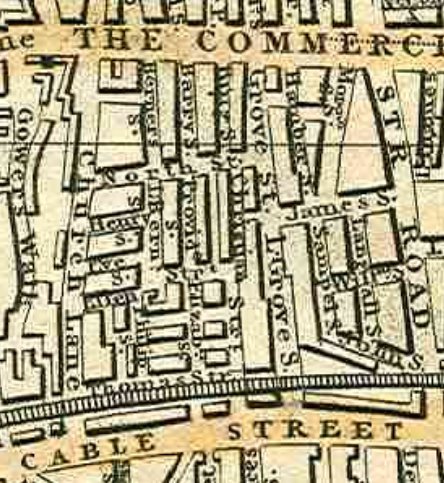 The St. Mary's district of St George's in the East was accordingly
selected for the elaborate analysis which it was determined to make;
and the portion concerning which it was ultimately found practicable to
obtain every varied item of information, was the great block of
habitations included between White Horse Lane, which is the
commencement of the Commercial Road, on the north, and Cable Street and
the New Road on the south; and between the New Road on the east and
Church Lane on the west. This is, in fact, the whole of St Mary's
district north of Cable Street; and it is one of those composed of
dingy streets, of houses of small dimensions and moderate elevation,
very closely packed in ill-ventilated streets and courts, such as are
commonly inhabited by the working classes of the east end; and indeed,
it may be said, of all parts of London beyond the limits of that
congested band round its centre, where overcrowding is carried to the
greatest excess.
The St. Mary's district of St George's in the East was accordingly
selected for the elaborate analysis which it was determined to make;
and the portion concerning which it was ultimately found practicable to
obtain every varied item of information, was the great block of
habitations included between White Horse Lane, which is the
commencement of the Commercial Road, on the north, and Cable Street and
the New Road on the south; and between the New Road on the east and
Church Lane on the west. This is, in fact, the whole of St Mary's
district north of Cable Street; and it is one of those composed of
dingy streets, of houses of small dimensions and moderate elevation,
very closely packed in ill-ventilated streets and courts, such as are
commonly inhabited by the working classes of the east end; and indeed,
it may be said, of all parts of London beyond the limits of that
congested band round its centre, where overcrowding is carried to the
greatest excess.
The civil
district of St George-in-the-East had three sub-districts, St Mary's,
St John's and St Paul's. The area surveyed was shown on
this 1844 map: before Commercial Road was developed it was known as
White Horse Lane [not to be confused with the present-day White Horse
Lane further east], Church Lane was not known as Backchurch Lane until
the 1860s, and Cable Street east of Cannon Street Road was still called
New Road.
The period occupied in the inquiry was chiefly the summer half of the
year 1845, and the abstract was made in the course of the following
year. Annexed [not included here] is the form of a table in which the particulars relating
to the several families in each house were carefully registered, after
they had been collected in note books with marginal indications
corresponding with the headings of this table. A complete
re-arrangement of the materials was then made under the head of each
occupation. From these second abstracts the following tables have been
compiled.
The annexed preliminary table shows the condition of all the streets in
this region, with the exception of Upper and Middle Grove Streets,
which are almost wholly occupied by persons in a condition of life
somewhat above that of the poor labourers who surround them.
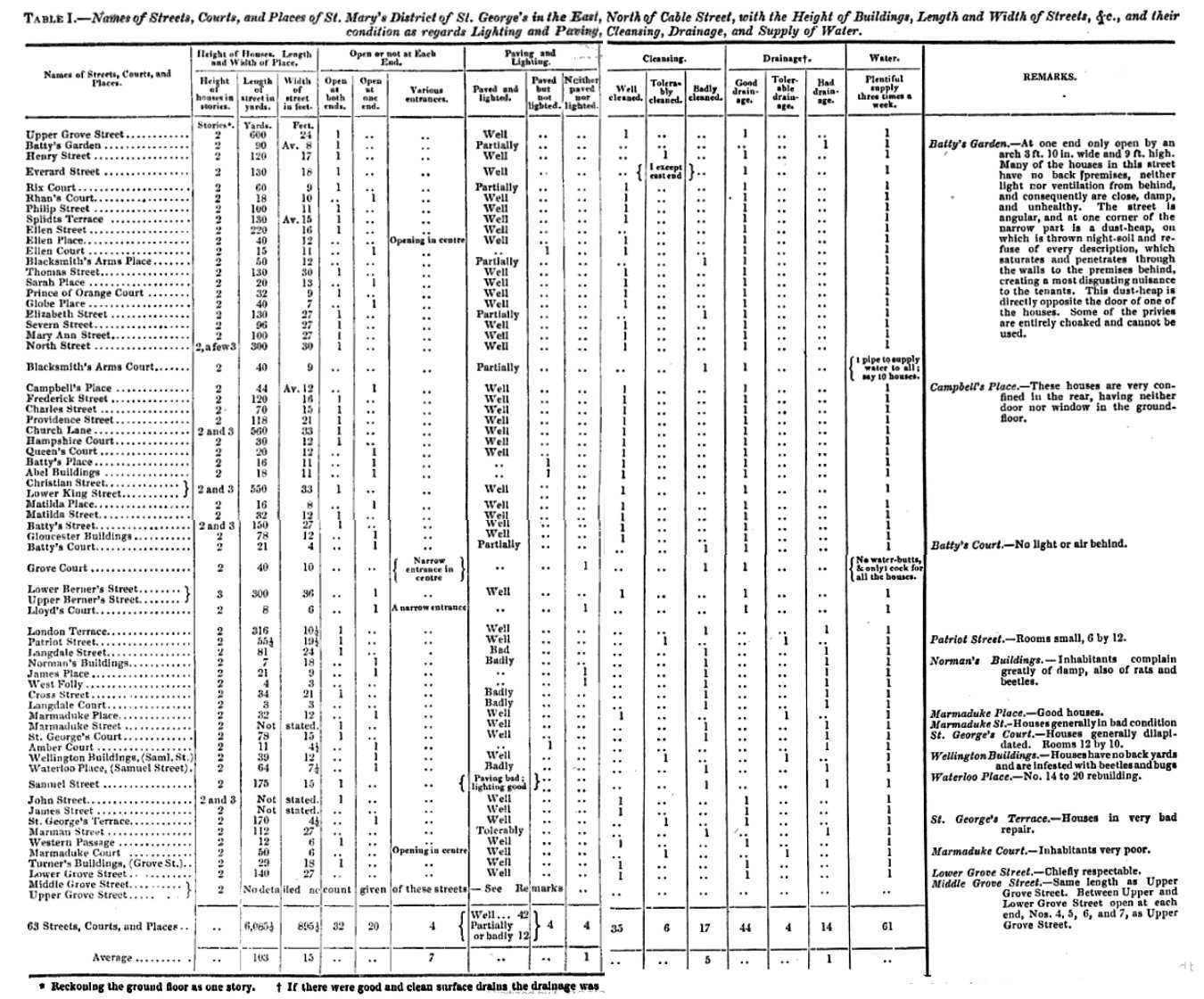
See here
for Upper, Middle & Lower Grove Street, later the site of St John
the Evangelist-in-the-East Church; note the exclusion of part of it as
being 'chiefly respectable'. The extent of paving and lighting is
higher than might be expected. Many of the courts and yards were to
disappear by the turn of the century.
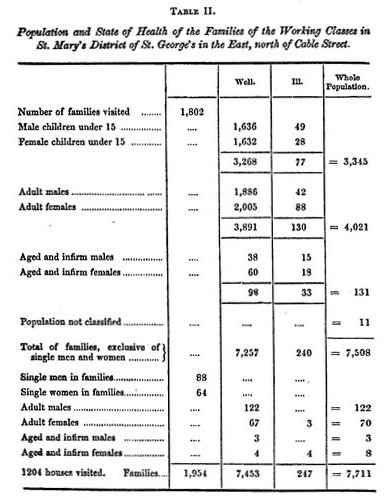 Illness, in the meaning of the following table (II), is such as produces
confinement to the house, and incapacity for labour or exertion. The
proportion of such illness is small; and the appearance of the
children, even, is very healthy, wherever there is a sufficiency of
food; for they are early sent, as much as possible, out of the confined
rooms of their parents, though sometimes into little, filthy, smoky,
dame schools, by no means preferable; except that they have to pass
through the streets to arrive at them. Others of these schools,
however, are clean and fairly ventilated, and kept by persons with
habits of order and propriety.
Illness, in the meaning of the following table (II), is such as produces
confinement to the house, and incapacity for labour or exertion. The
proportion of such illness is small; and the appearance of the
children, even, is very healthy, wherever there is a sufficiency of
food; for they are early sent, as much as possible, out of the confined
rooms of their parents, though sometimes into little, filthy, smoky,
dame schools, by no means preferable; except that they have to pass
through the streets to arrive at them. Others of these schools,
however, are clean and fairly ventilated, and kept by persons with
habits of order and propriety.
Health is further considered below.
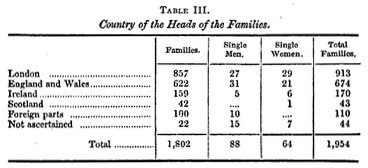 The excess of foreigners, indicated by this table (III), is partly
attributable to some foreign sailors having their homes here, but
chiefly to the sugar bakers, being nearly all Germans; and to their
credit it ought to be added, that they are a cleanly, orderly, and well
conducted body of men, chiefly worshippers at the German chapel in the
neighbourhood.
The excess of foreigners, indicated by this table (III), is partly
attributable to some foreign sailors having their homes here, but
chiefly to the sugar bakers, being nearly all Germans; and to their
credit it ought to be added, that they are a cleanly, orderly, and well
conducted body of men, chiefly worshippers at the German chapel in the
neighbourhood.
Irish immigration continued through the coming decades, concentrated in particular streets. See here for more about sugar baking, and here for
the German churches. The sugar-bakers were from Christian regions, but
other German settlers were Jewish - though the days of this as a
Jewish-majority area were several decades away.
The total population–men, women, and children–included in the scope of
the present inquiry is here seen to be 7,711, comprised in 1,204
houses, and 1,954 families; reckoning as a separate family every one
whose earnings were not thrown into some common stock, for boarding and
lodging. 125 single men included in the inquiry, are thus reckoned to
form 88 families; because some of them lodge together; and 78 single
women and widows without incumbrance, make in like manner, 64 families,
an excess of gregariousness on the part of the men which is worthy of
observation.
Is it really noteworthy that single men (especially labourers) were more likely to
share accommodation than single women? See here for details about common lodging houses - mostly for men, but some for women, and a few mixed.
The economical condition of single persons of both sexes being
altogether different from that of the great mass of the population,
they are kept under separate heads in the following abstract, as also
are 151 widows, with incumbrance, the total number in whose families
amounts to 577, or nearly 3½ in each family, while the general average
of the district is 4. The remaining 1,651 families, including 6,991
individuals, or 4¼ individuals to each, are classified, as far as
possible, according to the occupation of the head of each; being that
circumstance which brings in its train the most numerous and most
potent of the influences which affect the relative condition of all.
Every occupation which had any considerable number of the heads of
families engaged in it, is, in fact, separately specified in the
following tables, and they are 27 in number; leaving a surplus of 396
families, including 1,663 individuals, still unclassed, under the head
of miscellaneous. These, however, are all brought together in a
separate sheet, similar to those in which the whole of the particulars
concerning each of the other groups is abstracted. Annexed is a list of
these groups, with the numbers in each, from which it will appear that
the number of mere "labourers" (in great part about the docks) is alone
nearly equal to all the "miscellaneous"; while of shoemakers there are
101, gunsmiths 87, carpenters 76, tailors 72, sailors 67, coopers 64,
carmen 50, &c. This list is followed by a classification of the
"miscellaneous" under the heads of their several occupations.
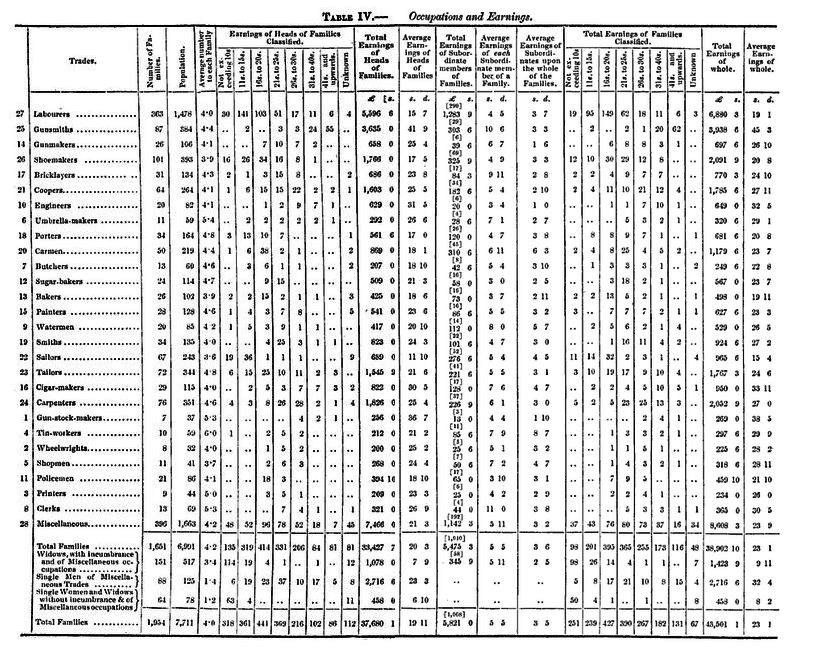
[Table V - Classification of the 396 "Miscellaneous" heads of families:]
Agents (3), Actor, Accountant, Artists (2), Box-makers (2), Basket &
Brush-makers (6), Boiler-makers (4), Bedstead-makers (3), Block and
Last-makers (3), Brass-workers (2), Brass polisher, Brass-founder,
Brewers (4), Bell-founder (1), Boat-builder, Bookbinders (3), Builder,
Broker, Brass-finisher, Bell-hanger, Boot-blocker, Bookseller,
Chimney-sweepers (2), Coal-whippers or porters (9), Coachmen (2),
Cabmen (2), Coppersmiths (2), Coachmakers (3), Costermongers (13),
Cabinet-makers (!0), Cellarmen (6), Corn-porters (2), Cork-cutters
(12), Custom-house-officers (7), Coach-trimmer, Confectioners (5),
Comb-makers (2), Cap-maker, Coach-plater, Carvers and gilders (7),
Case-maker, Chair-maker, Corn-dealers (3), Chemists (2),
Coffee-roasters (2), Chair-bottomer, Chandler's-shop, Colour-maker,
Cane-worker, Captains (3), Draymen (4), Dyers (3), Drover,
Dock-constable, Dealers (2), Draper, Dairyman, Engravers (2), Excisemen
(2), Excise-officer, Fishmongers (6), Foremen (4), Firemen (3),
Furriers (2), French-polishers (2), Founder, Gas-workers (2), Grocers
(6), General-dealers (5), Gas-stoker, Glass-cutters (2), Gate-keeper,
Ginger-beer-seller, Hatters (7), Hair-dressers (2), Hawkers (5), House
of ill-fame, In East India-house, In Docks (2), In Post-Office (4), In
Tower, Jewellers (4), Japanners (2), Ironmonger, Interpreter,
Lamplighter, Lucifer-maker, Milkmen (6), Mathematical-instrument-makers
(4), Masons (3), Maltster, Millwright, Millman, Messengers (4),
Marine-store, Oilman, Ostlers (5), Old-clothesman, Omnibus-driver,
Opticians (2), Potmaker, Plumbers (4), Public singer, Pencil-maker,
Plasterers (6), Pewterer, Poulterers (2), Paper-maker, Polisher,
Postman, Pensioners (3), Picture-frame-makers (2), Paper-hanger,
Paviour, Publican, Pew-opener, Packers (2), Riggers (6), Rope-maker,
Rule-maker, Satin-dresser, Ship-carpenter, Sawyers (10), Soldiers (2),
Soap-makers (2), Scale-maker, Sail-makers (4), Spiceman, Salesman,
Seller of trimming, Ship storesman, Servant, Surveyor, Turners
(4), Toy-makers (2), Travellers (2), Tanner, Trimmer, Timber-seller,
Tide-waiter, Vat-makers (2), Weavers (2), Watchmen (6), Watchmakers
(5), Warehousemen (5), Wire-workers (2), Waiter, Trades not given (26)
- total 396
These
lists make interesting reading. Some of the 'miscellaneous' occupations
might seem to belong within one of the categories of the main list, but
they are mainly distinctive trades, some of them highly-skilled, plus a
scattering of 'professions'. The gun trade was well-established in the
area, due to its proximity to the Proof House;
shoemaking and tailoring, with their related trades, were to remain
significant as Jewish immigration increased. There was a small gasworks
in the area. Notice the 'pew-opener' (which also features in the list
of 'widows with incumbrances') - paid a small wage, plus tips, for
ushering the gentry to their rented seats in church.
From the following (Table VI.), which shows the occupations, earnings,
and ages of the single men, widows with incumbrance, and single women,
it will be seen that the former are chiefly very young men, especially
those in the trades, earning good wages; while in the two latter
classes we find much greater diversity of age, with very limited means
derived from the narrow range of employments available for female
hands, especially if unaccompanied by a vigorous frame and habits of
bodily exertion. The extent of such employments, as compared with the
number of struggling competitors for them, being always limited, their
remuneration is always very low. The relative superiority of men's
earnings over those of the women, and even over those of the women and
children combined, in the metropolis, as compared with most of the
manufacturing districts, is thus very conspicuously shown. The
"distressed needlewomen" are undoubtedly a numerous class, in most
parts, and especially in this part of the metropolis; unprotected
women, in this district alone, being no fewer than 229, while the
number of unmarried men is only 125. A glance at the tables which
show their scanty earnings, and the numerous families which are
dependent upon two-thirds of them, will convey a sufficient idea of the
position of moral as well as pecuniary difficulty in which they are
placed. Some of the women included in this class are, indeed, widowed
only by the abandonment of their husbands. All, however, are living
unprotected, with families dependent upon them.
All those specified as unfortunate females appear, with only a few
exceptions, to be persons of respectable outward manners and conduct,
for the houses of prostitution were expressly excepted from inquiry,
beyond a rough enumeration of them and of their inmates, since they
form a distinct feature in society which it was not our present purpose
to investigate. Unhappily there are many houses of this description
within the topographical limits of the present inquiry, frequented
chiefly by sailors, low mechanics, and labourers, at least fifty coming
within the observation of your Committee's agents.
It is a pity
that these houses are 'expressly excepted' - the information would be
interesting. One head of family in Table IV is listed as 'house of ill
fame'.
Although
the numbers below are in some cases too small to be statistically
significant, the report is prescient in separating 'family' and 'single'
occupations. See here for emigration schemes for 'distressed needlewomen'.
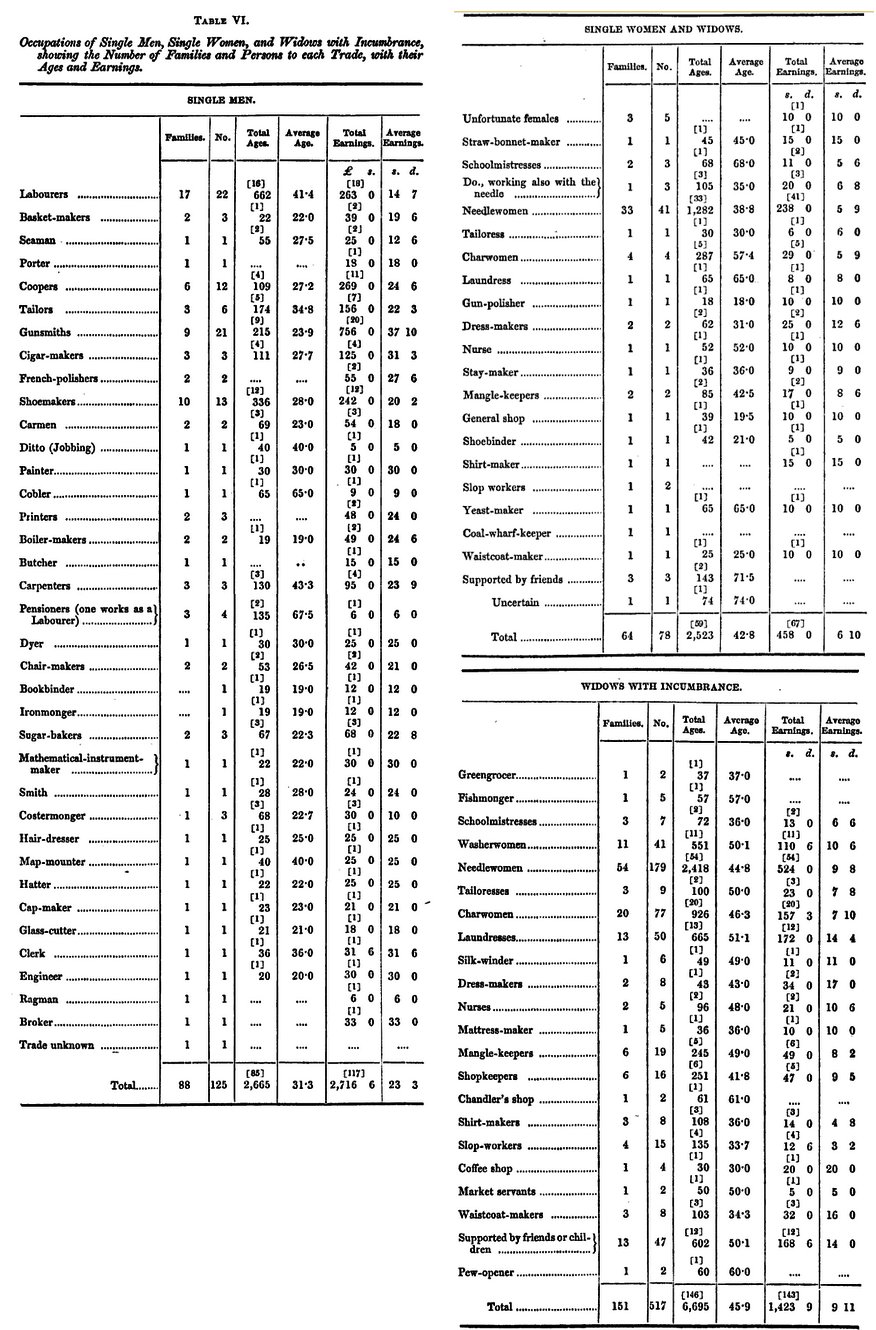
The wages are seen to vary (Table VI.) as usual, with the degree of
skill required in the several trades; the lowest being those of the
sailors, 11s. 10d. per week besides rations, and of the mere labourers, 15s. 7d. per week, on the average; the highest, those of the gunsmiths, 41s. 9d. per week; the general average being 20s. 2d. per week. Including the earnings of all the family, the incomes of the sailors average 15s. 4d. per week, of the labourers 19s. Id., and of all the rest, various sums between 20s. and 40s., with the exception of the gunsmiths, whose total emoluments per family average 45s. 3d.
per week. Necessity, on the one hand, in the poorer trades, and
opportunity, on the other, in some of the better paid, cause the amount
of subordinate earnings to equalize each other in the families of some
of the men who earn, themselves, a very unequal amount of wages; while
those unmoved by either peculiar necessity or peculiar opportunity,
show least of pecuniary advantages derived from the labour of women and
children. In a few cases, the earnings of a grown up-son give an excess
which disturbs the average from its usual value as an index to the
earnings of women and children, and it must carefully be borne in mind
that there may be the most industry, and that of the most appropriate
kind, in those families whose subordinate members add little or nothing
to their pecuniary resources; for the labours and cares of the little
household, in homes which can afford the employment of only casual if
any domestic service, are quite sufficient to occupy all available time
and ability in their proper discharge. In the case of the tailors, the
proportion of the wife's earnings is greater than would appear from the
table, because the females assist the men in the work, for which
payment is entered under the head of the husband's wages; but, in all
other cases, the additional sums are drawn from the sources indicated
in the case of the unprotected women.
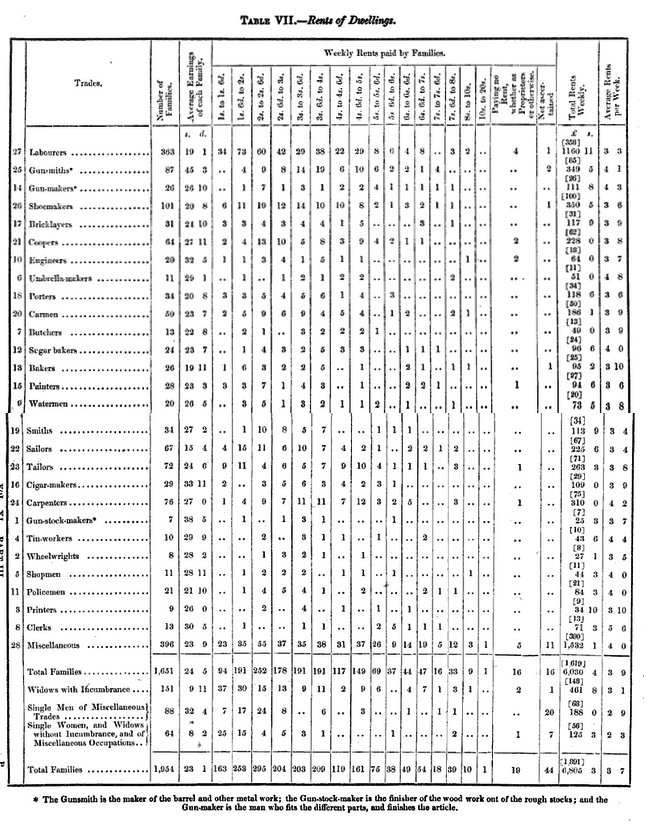 The preceding table (VII.) shows, in comparison with the average
earnings of the families in each trade, their weekly payments for rent,
carefully classified; the next following (VIII.) shows the number of rooms
occupied by the families, and the number of persons to a room; while a
third (IX.) states the number of beds possessed by each, and the number of
cases where there are one, two, three, or any greater number of persons
to a bed. The only remarkable result is the moderate degree of crowding
which prevails throughout the population. It is greatest, of course, in
the families having only one room, with several little children, but it
steadily decreases as each class increases in the number of its rooms
and its beds, showing that this is a population entirely above the
wretched system of sub-letting corners of the same room, which
occasions such an accumulation of wretchedness, barbarism, and disease,
in the few localities to which the rudest and most unsettled of the
population resort. Want of space and ventilation in the rooms is,
however, observed generally, and everyone can conceive how unfavourable
it is to domestic quiet to have only one room for every purpose of
repose and the ménage.
Indeed, the possession of only one room, indicates a depression of
habits and of health, which, if every grosser feature of misery were
removed, would well deserve the solicitude of the philanthropist; the
provision of a second room in town-life being as marked a step as the
advancement from a hovel to a proper cottage in the country.
The preceding table (VII.) shows, in comparison with the average
earnings of the families in each trade, their weekly payments for rent,
carefully classified; the next following (VIII.) shows the number of rooms
occupied by the families, and the number of persons to a room; while a
third (IX.) states the number of beds possessed by each, and the number of
cases where there are one, two, three, or any greater number of persons
to a bed. The only remarkable result is the moderate degree of crowding
which prevails throughout the population. It is greatest, of course, in
the families having only one room, with several little children, but it
steadily decreases as each class increases in the number of its rooms
and its beds, showing that this is a population entirely above the
wretched system of sub-letting corners of the same room, which
occasions such an accumulation of wretchedness, barbarism, and disease,
in the few localities to which the rudest and most unsettled of the
population resort. Want of space and ventilation in the rooms is,
however, observed generally, and everyone can conceive how unfavourable
it is to domestic quiet to have only one room for every purpose of
repose and the ménage.
Indeed, the possession of only one room, indicates a depression of
habits and of health, which, if every grosser feature of misery were
removed, would well deserve the solicitude of the philanthropist; the
provision of a second room in town-life being as marked a step as the
advancement from a hovel to a proper cottage in the country.
The average rent is seen to be no less than 3s. 7d. per week, or 9l.
6s.4d. per year, which, on the total number of families (1,954),
gives the enormous sum of 18,204l. 16s. 8d. The present Committee, in
relation to this subject, would earnestly recal [sic]
the attention of the Members of the Society to the practical suggestion
contained in the Report of their Committee on the state of the working
classes in the parishes of St. Margaret and St. John, Westminster, read
at the Ordinary Meeting of the Society on the 16th of March, 1840, and
which has already been the source of much good in the origination of
societies for the improvement of the dwellings and the lodging-houses
of the labouring classes, and offers a test from which yet more
enlarged practical deductions might be drawn, at a time when express
provisions for the physical and moral health of our vast urban
populations are at length recognised as a part of the public policy of
the empire:
High rents are an evil of a practical
nature from which the labouring classes are severely suffering; and a
sufficient proof of this circumstance is afforded in the fact that
large numbers of the families of the working population continue to
reside, for months and years together, crowded within miserable
dwellings, consisting of a single room, of very moderate size, for each
family. As a remedy for such
an obvious grievance, the Committee are desirous to show the advantage
which may be derived from the outlay of a moderate amount of capital,
in the erection of buildings containing sets of rooms suited to the
accommodation of labouring families in properly selected situations.
For these dwellings, weekly rents should be required from the tenants,
and a profit may, in this manner, be reasonably expected from capital
judiciously invested, while advantages of still greater importance,
both physical and moral, would be gained to society from the removal of
a serious cause of discontent among the working classes, and from the
provision of a more correct and convenient arrangement of their
household comforts, which may materially assist in the foundation of a
superior moral character for the working population.
See here for a brief history of 'model dwellings', and here for later developments in this parish.
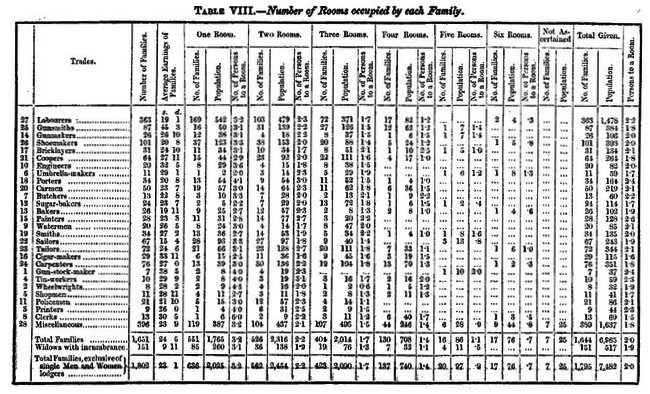
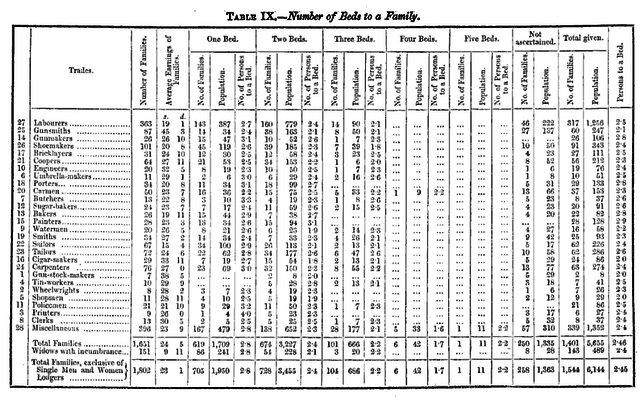
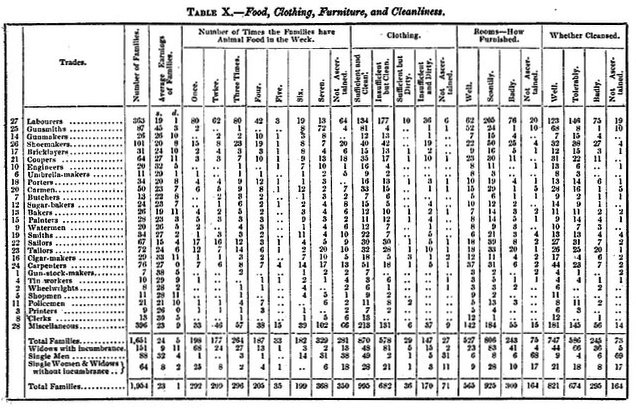 The state of these poor families, with regard to food, clothing,
furniture, and cleanliness, is described in Table X. There seems
to be indicated by the column showing the consumption of animal food, a
classification into poor and sufficient feeding; the former being very
clearly indicated by the two columns which represent those who very
clearly by represent obtain animal food only once or twice a week;
being about one fourth of the whole. None appeared to be over-fed. The
state of the clothing is, in one sense, more satisfactory; for while it
is described as sufficient in 1,031 cases, and insufficient in 852, it is described as dirty
in only 36 of the former cases, and 170 of the latter. The distribution
of these latter numbers chiefly among the poorer occupations will be
seen at a glance. Only 300 are returned as having rooms ill furnished, while 565 have rooms well furnished, but a number greater than both of these combined (925) are described as having only scanty
furniture; terms which are tolerably expressive to those accustomed to
visit the habitations of the poor. Ill furnished dwellings are those in
which there are only a wretched bedstead, or a bed on the floor, a few
broken chairs, and a table worth only a shilling or two, besides,
perhaps, a box or chest with a few paper pictures about the walls.
Scantily furnished dwellings are those which contain a few chairs, a
deal table, a flock bed, and a few cooking utensils, altogether
indicating a struggle towards neatness, though scarcely towards
comfort. While the dwellings described as well furnished had, perhaps,
a chest of drawers, a clock, really good tables, a carpet, mahogany
chairs, and every article essential to comfort, and some even of
luxury, such as a piano, violins, and other musical instruments, with
foreign productions of curiosity, &c.
The state of these poor families, with regard to food, clothing,
furniture, and cleanliness, is described in Table X. There seems
to be indicated by the column showing the consumption of animal food, a
classification into poor and sufficient feeding; the former being very
clearly indicated by the two columns which represent those who very
clearly by represent obtain animal food only once or twice a week;
being about one fourth of the whole. None appeared to be over-fed. The
state of the clothing is, in one sense, more satisfactory; for while it
is described as sufficient in 1,031 cases, and insufficient in 852, it is described as dirty
in only 36 of the former cases, and 170 of the latter. The distribution
of these latter numbers chiefly among the poorer occupations will be
seen at a glance. Only 300 are returned as having rooms ill furnished, while 565 have rooms well furnished, but a number greater than both of these combined (925) are described as having only scanty
furniture; terms which are tolerably expressive to those accustomed to
visit the habitations of the poor. Ill furnished dwellings are those in
which there are only a wretched bedstead, or a bed on the floor, a few
broken chairs, and a table worth only a shilling or two, besides,
perhaps, a box or chest with a few paper pictures about the walls.
Scantily furnished dwellings are those which contain a few chairs, a
deal table, a flock bed, and a few cooking utensils, altogether
indicating a struggle towards neatness, though scarcely towards
comfort. While the dwellings described as well furnished had, perhaps,
a chest of drawers, a clock, really good tables, a carpet, mahogany
chairs, and every article essential to comfort, and some even of
luxury, such as a piano, violins, and other musical instruments, with
foreign productions of curiosity, &c.
The rooms are badly cleaned in a greater number of cases than the
clothing, viz., in 295, and in 674 they are but tolerably clean. Still,
in one half of the cases ascertained (821), they are described as well
cleaned. The excess of inferior habits in the lower occupations will be
traced generally. The casual dock labourers appear to be in the lowest
condition, in proportion even to their poor means; while those whose
homes are most comfortable, in proportion to their earnings, are
undoubtedly the German sugar-bakers, and the mates of vessels, with
only a part of the gunsmiths; others throwing away all the advantages
of their superior earnings by thriftless habits.
Some evidence as to the religious and moral character of the people
will be conveyed by the table which describes their profession of
religion, the newspapers and periodical publications which they read,
and the character of the books and pictures found in their apartments.
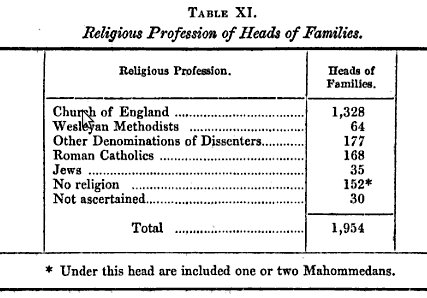 This extensive profession of attachment to the Gospel is a hopeful
sign, though the limited extent to which the Wesleyans and other
denominations of Dissenters, appear to have penetrated into this mass
of population, is rather remarkable, and will justify a feeling of
doubt with regard to the profession made by some of belonging to the
Established Church.
This extensive profession of attachment to the Gospel is a hopeful
sign, though the limited extent to which the Wesleyans and other
denominations of Dissenters, appear to have penetrated into this mass
of population, is rather remarkable, and will justify a feeling of
doubt with regard to the profession made by some of belonging to the
Established Church.
There is reason to believe, however, that the above statement gives a
very fair representation of the results which would be arrived at
amidst large bodies of the working classes, whether in town or country;
though a different result would probably be shown in the manufacturing
districts.
Given the
large number and variety of dissenting and nonconformist chapels in the
area (which makes singling out Wesleyan Methodism misleading), many of
which were more congenial to the poor than the 'mighty' Church of
England, adherence at roughly 10% of that of the established church is
perhaps surprising. But these were churches requiring definite
membership, unlike the 'hatching, matching and dispatching' of nominal
Anglicans, so the 'feeling of doubt' is justified. See here
for rather different figures from the 1851 religious census across the
whole parish, and here for the first of four pages on dissenters in the parish. The presence of Roman Catholics was already significant,
but of Jews still modest; and Muslims are included under 'no religion'
as an oddity, despite (or perhaps because of?) a number of lascar seamen in the surrounding area.
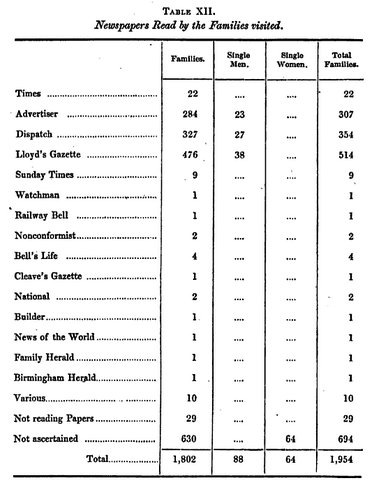 The following are the periodical publications in use among population:—
The following are the periodical publications in use among population:—
This is not a cheering picture; the great use made of the capacity to
read being, so far as this statement indicates, in ministering to mere
excitement. Out of 1,260 cases in which the circumstances with regard
to reading were ascertained, it was wholly in "Lloyd's Gazette", the
"Weekly Dispatch", and the "Advertiser", in every case, except 22 in
which the "Times" is read, 34 in which other miscellaneous prints are
taken in, and only 29 in which no newspaper whatever is read.
'Mere
excitement' seems a harsh judgement: it is surely remarkable that over
half the households took newspapers of some kind, and hardly surprising
that only a few read the market leader, the heavyweight Times (first appearing under this title in 1788). There were seven morning dailies at this time: Times, Morning Advertiser, Morning Herald, Morning Chronicle, Morning Journal, Morning Post, and Public Ledger. Of these, the Times' daily circulation in 1846 was 28,594, against 38,969 for all the others; but by 1854 The Times was selling 51,648, against 26,000 for the rest, of which only the Morning Advertiser's circulation had risen. The local popularity of Lloyd's Gazette (first published as Lloyd's News in 1696, becoming Lloyd's List & Shipping Gazette
in 1734) was that it combined general and shipping news - it would not
have predominated elsewhere. Next most popular here was the Weekly Dispatch,
published in Fleet Street from 1801 with 4 pages at 6d., and perhaps
the first 'modern' newspaper, since it aimed to be 'at once instructive
and entertaining', with 'sporting intelligence' - including boxing -
and lighter news ('occurrences of a subordinate kind') as well as
parliamentary reports from its own reporter. It promised to 'convey the
most authentic, interesting and useful information up to the very
moment of being put to press; every great event occurring on the
Continent of Europe and in all places where our Naval and Miltary
Operations are carried on; every question of War or Peace and
everything connected with the interests of the British Empire', and to
be politically independent, unconnected with factions or parties. The Morning Advertiser was
the 'pub paper', first published in 1794 by the Society of Licensed
Victuallers and available in every bar. It majored on trade interests
rather than party politics, and was heavily promoted by the Society, so
although it was not read in places of influence its circulation rose
during this period. Charles Dickens was a contributor. The title
remains, as a weekly magazine for the pub trade.
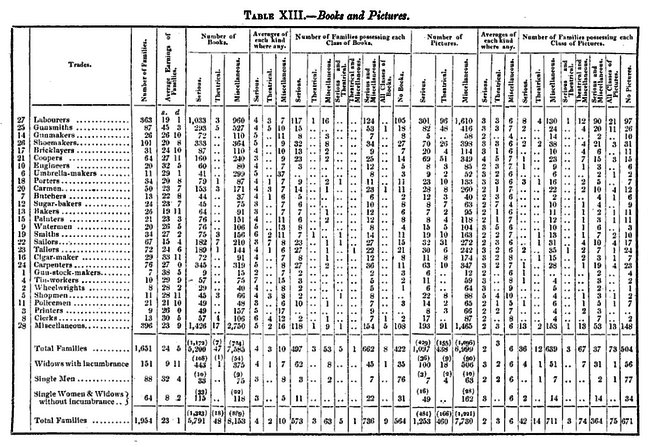
The classification of the books and pictures found in the houses, which
has been adopted in the accompanying table, has been made in deference
to a former classification in like inquiries. The head "Miscellaneous"
is designed to include the miscellaneous books, chiefly of narrative,
and seldom of "useful knowledge", which are found in the houses of the
poorer classes, distinct from the books of religion and morality
comprised under the name of "serious", and the melodramatic works
which, chiefly, are designated by the term "theatrical". The total
number of books found in the district was no less than 13,992, giving
an average of upwards of 11 for each of the families in which they were
found; 564 appearing to be without books of any kind; a proportion
upwards of one fourth of the total number. Only 58 books were found to
be theatrical, while 5,791 are classed as serious, and 8,153 as
miscellaneous. The former were found in only 18 families of the whole
number visited, while all three classes were found in 9 of these;
serious as well as theatrical in 5 more of them; and miscellaneous as
well as theatrical in another; leaving but 3 in which theatrical books
only were found. Both serious and miscellaneous books were found in 736
families; serious books only in 573; and miscellaneous books only in
63. The possession of books is, in fact, almost universal; and in the
families in which each kind of books was found at all, therefore, there
were on an average, 4 serious, 10 miscellaneous, and 3 theatrical. The
extent to which the habit of reading prevails, challenges, therefore,
still more minute investigation into the direction given to it, an
investigation which should extend to some simple observation upon the
apparent use, as well as the actual possession, of the books, and a
yet further classification of them. It is more than one-fourth of the
houses which are without "serious" books, under which name are
generally included the Holy Scriptures and books of prayer; and to what
extent these are really used it must be impossible to ascertain
statistically, but it would be very important to determine whether or
not they appeared to be most used in the houses where they were
accompanied by an equal or perhaps greater proportion of miscellaneous
books. The impression of the agents is, that, in far the greater number
of families which they visited, of all the books which they found in
them, the "Bible" and "Testament" were those least read.
The decoration of the walls with pictures prevails to nearly the same
degree as the possession of books of some kind. The total number of
pictures observed was no fewer than 9,443, of which 7,730 had
miscellaneous, 1,253 serious, and 460 theatrical subjects; the
proportions of the miscellaneous and theatrical being greater in the
pictures than in the books; the numbers of each kind in the families
where they were found at all, averaging, of the serious 2, of the
theatrical 3, and of the miscellaneous 6. These numbers give upwards of
8 to a family, in the case of all the families indulging in this sort
of decoration. In the abodes of 75 families were found pictures of all
these denominations; in 364, serious and miscellaneous pictures; in
711, miscellaneous pictures only; in 74, miscellaneous and theatrical;
in 42, pictures on religious subjects only; in 14, on theatrical
subjects only; in 3, on both serious and theatrical subjects. In 671,
or one-third of the abodes, there was no decoration whatever by
pictures. Those usually found were little paper prints, tricked out in
glaring colours, and enclosed in little black frames of wood; while a
few, especially the marine prints, were really good.
Such detailed
gathering and classifying of information would hardly be possible today
- though the comment about the unread Bible still rings true!
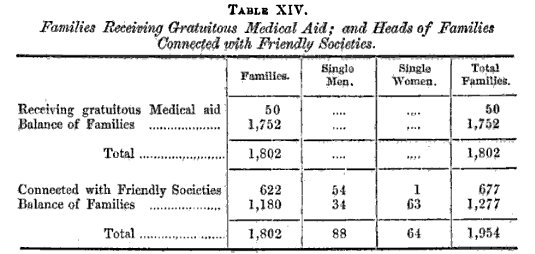 One very gratifying fact is that 622, or upwards of one-third of the
heads of families are connected with Benefit Societies. On the other
hand, however, 50 families were in the actual receipt of gratuitous
medical relief.
One very gratifying fact is that 622, or upwards of one-third of the
heads of families are connected with Benefit Societies. On the other
hand, however, 50 families were in the actual receipt of gratuitous
medical relief.
See here for more on friendly societies, and here for an example of a local medical charity. A generation later dispensaries for the 'deserving poor' were being promoted by those who opposed universal relief.
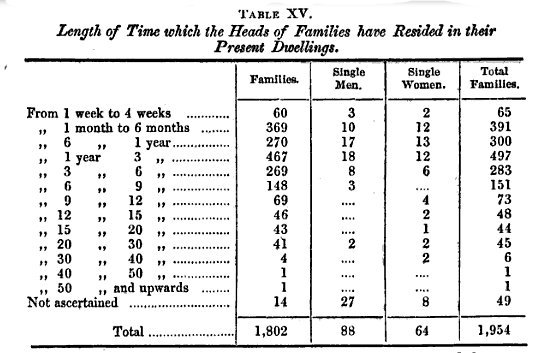 Again, the great length of time which a large proportion of them have
occupied their present habitations, indicates, in the main, a
steadiness of character which is worthy of observation, if we take into
account the large proportion of forced migration which attaches to a
number of the trades; if only from one part of the town to another.
Again, the great length of time which a large proportion of them have
occupied their present habitations, indicates, in the main, a
steadiness of character which is worthy of observation, if we take into
account the large proportion of forced migration which attaches to a
number of the trades; if only from one part of the town to another.
The pattern of
'forced migration' in search of work was certainly prevalent; equally,
many families moved from house to house within just a few streets, as
family and other circumstances changed.
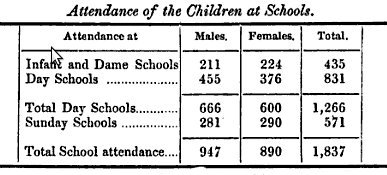 The tables of the attendance of the children in schools, and the payment made by their parents for that attendance, are very
interesting; indicating, as they do, an universal use of schools for
some period of life, and obviously also for successive years. Of the
quality of the schooling we have other and less flattering means of
judging, by analogy.
The tables of the attendance of the children in schools, and the payment made by their parents for that attendance, are very
interesting; indicating, as they do, an universal use of schools for
some period of life, and obviously also for successive years. Of the
quality of the schooling we have other and less flattering means of
judging, by analogy.
Thus, upon the total population of 7,711, the attendance in day-schools
is nearly 1 in 9; in infant and dame schools about 1 in 18; and in
both combined 1 in 6, or approaching one-half of the number not
exceeding 16 years of age. The number of young persons attending Sunday
Schools is seen to be 571, or 1 in 13½ of the whole population, and 1
in 6 of the population not exceeding 16 years of age. Thus, the school
attendance is respectable, even as shown by that in day-schools only,
and when the "out-of-the-way schools" for the "little ones" are
included, it is seen to wear an aspect which is unrivalled even by the
most glowing statistics of voluntary education, in which they
universally form so great a portion; probably, as here, about one
third. The Sunday School attendance is, without doubt, proportionably
less here than in the manufacturing districts, because the absence of
an extensive demand for juvenile labour relieves the pressure for
secular instruction on the Sunday, which causes no small part of the
excess in those districts.
This is a reminder of the origin of Sunday Schools, to offer basic education as well as religious instruction. See here for more detail about the schools in the parish at this period.
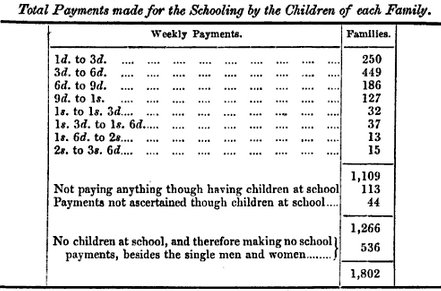
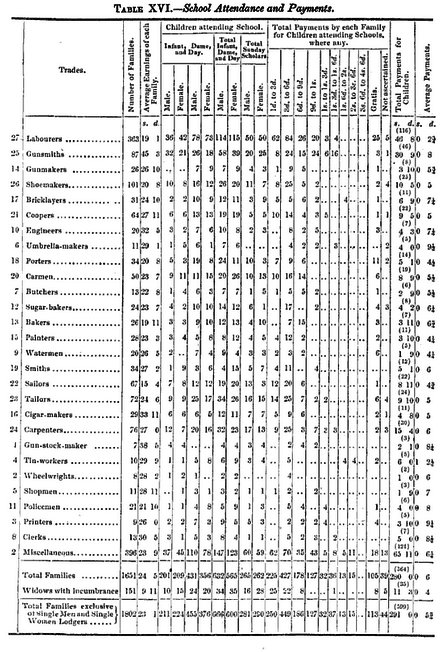 The table of school payments affords a very interesting view of the
payments which the several classes of families are willing to make for
the schooling of their children, while of all the families returned the
children of only 13 were receiving absolutely gratuitous education.
The table of school payments affords a very interesting view of the
payments which the several classes of families are willing to make for
the schooling of their children, while of all the families returned the
children of only 13 were receiving absolutely gratuitous education.
The total sum spent upon day schooling is thus 291s. = 14l. 11s. per week, or 1,056l. 12s. per annum, at a general average of 5¾d.
per week, contributed by each family which pays for schooling at all,
an amount which if distributed over all the families, would be under 2d. per week each.
The rest of
the report is a detailed statistical analysis linking parental age (and
occupation) with family size, to demonstrate a fairly obvious point
(which is why these complex tables are not included here): namely, that
the earlier a family is started, the larger it is likely to be. It then
considers the impact of this on infant and adult mortality, and on
health generally. It reaches the surprising conclusion that infant
mortality rates in the area surveyed are lower than in some more
affluent areas, and that children appear to be healthier than might be
expected given their environment; less surprisingly, adult mortality was high.
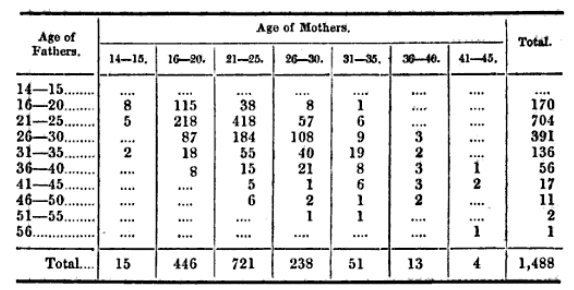 The following table will show the ages
of the parents at the birth of their first child; and if it be
assumed, that the birth of the first child, on the average, happened
about one year after marriage, it will be seen that in both sexes the
greatest number of marriages took place, between the ages of 21 and
25. However, it will be found that the marriages in the male sex have
taken place generally at a much later period in life than among the
female sex, for while out of 1,488 marriages 170 only of the males
were under 20 years of age, as many as 461 females were under the
same age. On the other hand, while 236 only of the females were
between the ages of 26-30, there were as many as 391 males at those
ages. Again, while there were only 68 females married above the ages
of 30, it will be found that as many as 223 males were married above
that age.
The following table will show the ages
of the parents at the birth of their first child; and if it be
assumed, that the birth of the first child, on the average, happened
about one year after marriage, it will be seen that in both sexes the
greatest number of marriages took place, between the ages of 21 and
25. However, it will be found that the marriages in the male sex have
taken place generally at a much later period in life than among the
female sex, for while out of 1,488 marriages 170 only of the males
were under 20 years of age, as many as 461 females were under the
same age. On the other hand, while 236 only of the females were
between the ages of 26-30, there were as many as 391 males at those
ages. Again, while there were only 68 females married above the ages
of 30, it will be found that as many as 223 males were married above
that age.
Tables A, B,
C, D, and E [not included here] exhibit facts of considerable interest and importance,
They are arranged to show the influence of the age at marriage on the
number of children born, and the mortality of those children. Table A
represents the results of those marriages, in which the birth of the
first child took place when the mother was between the ages 16-20.
The first column represents the number of years which have elapsed
since the birth of the first child. The Second—The
number of families over which the observations extend; the Third
—The number of
children born; the Fourth—The
number of children then alive; the Fifth—The
number dead; the Sixth—The
rate of mortality per cent., and the Seventh—The
average number of children born to each family within the given
periods of years set forth in the first column, as having elapsed
since the birth of the first child. Tables B, C, and D represent the
same class of facts for families in which the birth of the first
child took place between the quinquennial ages 21-25, 26-30, and
31-35; and Table E includes the results for all the marriages formed
at whatever period of life they may have taken place.
 Tables a, b, c, d, and e [not included here] are
abridgments of the preceding tables. The first point deserving of
attention in those figures is the circumstance that those marriages
formed at an earlier period of life are more prolific than those
formed at a later period. The gross results for each group of facts
is as follows: —
Tables a, b, c, d, and e [not included here] are
abridgments of the preceding tables. The first point deserving of
attention in those figures is the circumstance that those marriages
formed at an earlier period of life are more prolific than those
formed at a later period. The gross results for each group of facts
is as follows: —
To the results presented in this form,
however, it may be objected, that the number of years elapsed between
the birth of the first child over the time to which the facts are
collected, is, on the average, greater in the case of the earlier
marriages than in the later, and hence the greater number of
children. This objection, true in principle, will be found, under a
closer analysis of the figures, to materially alter the relative
bearing of the results. The following abstract will show the average
number of children to each marriage, at the respective periods of 10,
20, 30, and 40 years after the birth of the first child, for each
class of marriages formed at the four different quinquennial periods
of life.
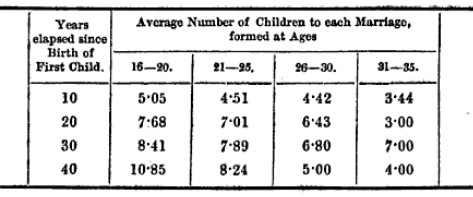 It is thus
obvious, that marriages formed under the age of 25, are more prolific
than those formed after that age, and that those formed between 16
and 20 years of age are still more so than those at any of the
superior ages.
It is thus
obvious, that marriages formed under the age of 25, are more prolific
than those formed after that age, and that those formed between 16
and 20 years of age are still more so than those at any of the
superior ages.
In connexion with these results, it is
important to view the rate of mortality of the children born in
marriages contracted at the same period of life.

These figures are of course subject to
the objection just alluded to, but the following abstract will show
the results in a corrected form.
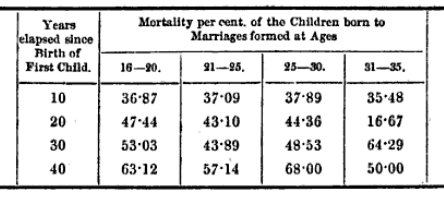 From this
abstract it is obvious, that of the three first periods, the children
born of marriages formed in the quinquennial term of life, 21-25, are
subject to a less rate of mortality than those of the period
immediately preceding or immediately followingm the rate of mortality
in the most advanced period 31-35, is very irregular, and no doubt
arises from the small number of families included in that group. The
two preceding series of facts furnish materials for the solution of a
very interesting and highly important question, namely, what is the
effect of the marriages formed at those different terms of life on
the ultimate increase of population? By the first of the two
preceding abstracts it was found, that the earlier the period of life
at which marriage was contracted, the greater the number of children
born; but by the second abstract a difference is observable in the
rate of mortality of the various periods, and this must disturb the
results in the first class of facts.
From this
abstract it is obvious, that of the three first periods, the children
born of marriages formed in the quinquennial term of life, 21-25, are
subject to a less rate of mortality than those of the period
immediately preceding or immediately followingm the rate of mortality
in the most advanced period 31-35, is very irregular, and no doubt
arises from the small number of families included in that group. The
two preceding series of facts furnish materials for the solution of a
very interesting and highly important question, namely, what is the
effect of the marriages formed at those different terms of life on
the ultimate increase of population? By the first of the two
preceding abstracts it was found, that the earlier the period of life
at which marriage was contracted, the greater the number of children
born; but by the second abstract a difference is observable in the
rate of mortality of the various periods, and this must disturb the
results in the first class of facts.
Let a represent the results given in
the first abstract; b represent those given in the second; then a - [a × b over 100] = the actual increase resulting from each
marriage to the population. The following is an abstract of the
results thus arrived at:
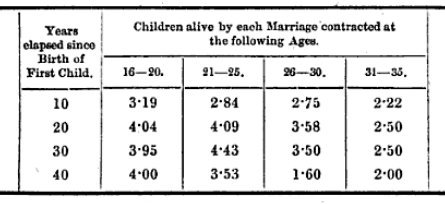 It hence
follows, that marriages formed under 25 years of age increase the
population more than those formed above that age; and on a close
examination it will be found, that there is very little difference in
this respect between marriages contracted at ages 16-20 and 21-25,
the rate of increase, however, being somewhat higher in the former
period. With regard to the last two quinquennial terms at which
marriage is formed, it will be seen that the rate of increase is not
so great for ages 26-30 as in that immediately preceding, and in the
period 31-35 the rate of increase is still less; in fact, the earlier
the period of marriage the greater the increase resulting to the
population, the difference between the first and second periods being
very little, between the second and third very considerable, about 23
per cent., and between the third and fourth about 20 per cent.
It hence
follows, that marriages formed under 25 years of age increase the
population more than those formed above that age; and on a close
examination it will be found, that there is very little difference in
this respect between marriages contracted at ages 16-20 and 21-25,
the rate of increase, however, being somewhat higher in the former
period. With regard to the last two quinquennial terms at which
marriage is formed, it will be seen that the rate of increase is not
so great for ages 26-30 as in that immediately preceding, and in the
period 31-35 the rate of increase is still less; in fact, the earlier
the period of marriage the greater the increase resulting to the
population, the difference between the first and second periods being
very little, between the second and third very considerable, about 23
per cent., and between the third and fourth about 20 per cent.
In the
consideration of these facts and observations, although they relate
to 1,506 families, from which have resulted 8,034 births, and of
which 4,616 children, or 57∙46
per cent., are still alive, it must be borne in mind that they
include only one class of the community, and may be subject to
disturbing influences, such as to destroy their character as a type
of the general population; however, there is reason to suppose that
these results may be a more faithful representative of the condition
of the whole population, than if they were derived from a like number
of facts from either the middling or higher classes of Society. On
reflection it will also be found, that the unfruitful marriages are
not included in any of those 1,506 families, all included being more
or less productive. Likewise, the marriages are all those in which
one or both the parents are still alive, and consequently the results
of fruitful marriages, in which the parents have died before the
lapse of the given period of years brought under review, are
excluded. An influence, independent of the relative number of
marriages at each age, will further affect the results arising from
the varying rates of mortality at the different terms of life, even
when equal numbers only at those periods are considered; and it will
follow, that fewer marriages of limited fruitfulness will be excluded
from the groups at the younger ages, the effect of which must be to
show in the preceding figures a reduced ratio of children at each
marriage formed at those periods of life, compared with that which
would appear were all cases included. The relative bearing of all the
results are therefore so far modified. Also, the children still
alive, composing 57∙46
per cent. of all born, may, subsequent to the period now under
observation, and when classified according to the ages at marriage of
their parents, show a very
different rate of mortality from that indicated in the respective
classes by those who have hitherto died, and still more extended
observations would be required to show, whether any and what
difference exist, in the fruitfulness of the marriages in the
succeeding generation. Lastly, all these remarks have had reference
to the age of the mother only at birth of her first child.
The next point to which attention is
directed, is the rate of mortality experienced by the children of
those families. This will be seen by an inspection of Tables A, B, C,
D, and E, as well as the abridgments of those tables, but as these,
from their peculiar construction, as well as from the small number of
families in some of the years, cause various irregularities in the
results, the following graduated abstract will exhibit the rate of
mortality for all the groups included in the preceding tables. The
mortality in the first year of life appears to be remarkably low,
being only 11∙86 per
cent., while, according to the Fourth Report of the
Registrar-General, the mortality during the first year of life was
for—
England and Wales
17∙355 %
For the County of Surrey 13∙278
%
For the Metropolis 20∙124
%
For Liverpool 28∙157
%
It will further be seen from the
following abstract, column 6, that of 100 children born, 62∙76
live to complete their tenth year:
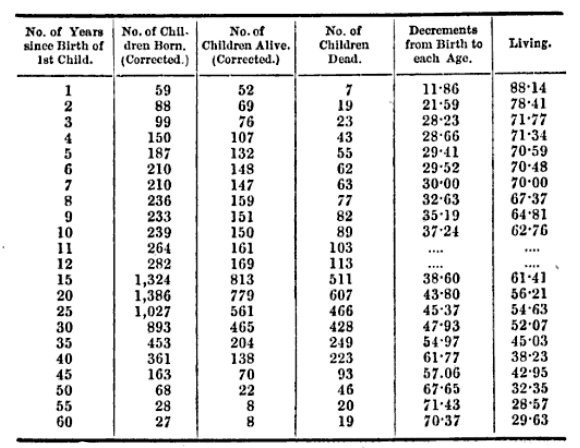
but according to the same report of the
Registrar-General, the number out of 100 born who live to complete
their tenth year is,—
For England and Wales
70∙61 %
For the County of Surrey 75∙42
%
For the Metropolis 64∙92
%
For Liverpool 48∙21
%
while according to the following
well-known life-tables, the number out of 100 born who live to
complete their tenth year is by the—
Carlisle Table (Milne)
64∙60 %
Sweden (Nicander) 63∙03
%
Select Lives in France (Deparcleux)
60∙04 %
Towns in France (Duvillard) 55∙11 %
Northampton (Price) 48∙71 %
Montpellier (Monyue) 43∙58
%
Again, the numbers living to complete
their 20th and their 30th years, according to each of the above
authorities, is as follows:—
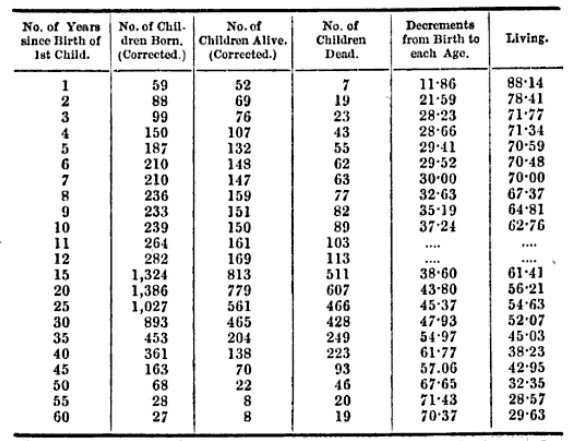 Beyond the
age of 30, the facts in this paper are not sufficiently numerous to
warrant a comparison being instituted between them and other life
tables, but from the illustrations already brought forward, it will
be seen that the rate of mortality in the first year of life, is less
than in any other of those cases. Again, with respect to the
decrement of life between birth and the tenth year, it is greater
than that for England and Wales, the county of Surrey, the
Metropolis, the Carlisle Table, and that for the kingdom of Swedenm
but less than the decrement for the select lives in Francem the towns
in France, Northamptonm Liverpool and Montpellier.
Beyond the
age of 30, the facts in this paper are not sufficiently numerous to
warrant a comparison being instituted between them and other life
tables, but from the illustrations already brought forward, it will
be seen that the rate of mortality in the first year of life, is less
than in any other of those cases. Again, with respect to the
decrement of life between birth and the tenth year, it is greater
than that for England and Wales, the county of Surrey, the
Metropolis, the Carlisle Table, and that for the kingdom of Swedenm
but less than the decrement for the select lives in Francem the towns
in France, Northamptonm Liverpool and Montpellier.
With respect to the decrements of life
up to the ages of 20 and 30, they will be found to hold the same
relative situation as that for age 10, being intermediate between
Sweden and the select lives of France.
Those remarks being applicable to all
the changes and fluctuations, taking place from birth up to the
various ages at which the comparisons are instituted, any
irregularity in the mortality of one period, the first year of life
for example, will disturb the results for all the subsequent ages. In
order, therefore, to avoid the effects of the force of this element,
it may be important to test the relative value of the different
classes of facts, by a comparison of the equation of life for the
different mortality tables. The following gives the result thus
arrived at, for one-fourth of the integral or original number.
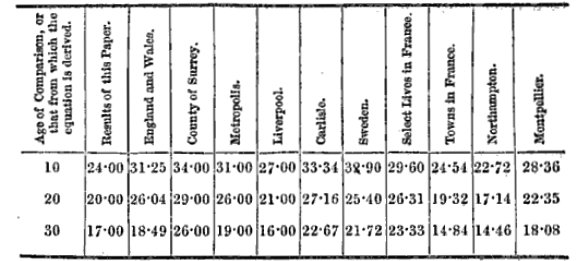 In viewing
the decrements of life from birth only, it was found that the results
of this paper were intermediate in the scale between the table for
Sweden and that for the select lives in France, that comparison was
of course affected by the rate of mortality in infant life; but in
the above tables, where the results of advanced life only enter into
the figures, it is seen that the mortality is higher than that of all
the tables, except those for the towns of France and for Northampton.
In viewing
the decrements of life from birth only, it was found that the results
of this paper were intermediate in the scale between the table for
Sweden and that for the select lives in France, that comparison was
of course affected by the rate of mortality in infant life; but in
the above tables, where the results of advanced life only enter into
the figures, it is seen that the mortality is higher than that of all
the tables, except those for the towns of France and for Northampton.
It is hence obvious, that so far as the
facts here brought forward can be relied on, the mortality of infant
life is very low, and that of advanced life high.
Lest the results of this inquiry,
however, should be deemed by some to fairly indicate the influence of
locality on the duration of life, of the inhabitants of this district
of Whitechapel, with equal truth for the early and advanced terms of
life, it may be well to draw attention to the following abstract,
showing the length of time which the principal members of families
have resided in their dwellings. [Table XV above has already presented these figures in slightly different form]
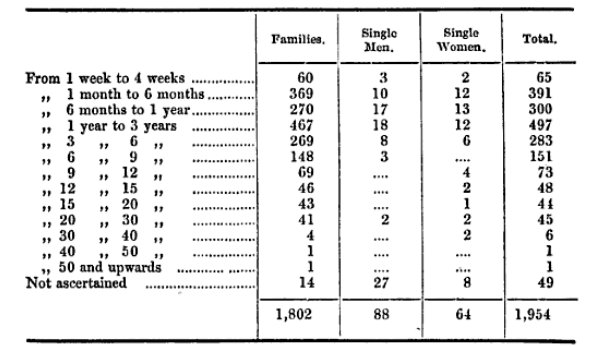 It will thus
be seen, that nearly two thirds of the families have been less than
three years in their present residence, and more than one-fourth
between one and three years only. The term "in their present
residence" will admit of the explanation that they may have been
much longer in the same neighbourhood. Still many amongst those who
have changed their dwellings must also have been recent inhabitants
of the locality, and it must therefore follow that the younger lives
indicate more strictly the sanatory [sic] condition of the place than
those of more advanced age. The high rate of mortality of the older
lives now under review can, consequently, not be attributable to
residence in Whitechapel, as the majority of the deaths in advanced
life may have taken place elsewhere—one-thirteenth
only of the families having occupied their present residences upwards
of twelve years; but with respect to the deaths at the younger ages,
the greater number of those must have happened in the locality, and
hence the comparative healthiness of the district.
It will thus
be seen, that nearly two thirds of the families have been less than
three years in their present residence, and more than one-fourth
between one and three years only. The term "in their present
residence" will admit of the explanation that they may have been
much longer in the same neighbourhood. Still many amongst those who
have changed their dwellings must also have been recent inhabitants
of the locality, and it must therefore follow that the younger lives
indicate more strictly the sanatory [sic] condition of the place than
those of more advanced age. The high rate of mortality of the older
lives now under review can, consequently, not be attributable to
residence in Whitechapel, as the majority of the deaths in advanced
life may have taken place elsewhere—one-thirteenth
only of the families having occupied their present residences upwards
of twelve years; but with respect to the deaths at the younger ages,
the greater number of those must have happened in the locality, and
hence the comparative healthiness of the district.
In regard to the state of health of the
families surveyed in the district now under consideration, it may be
interesting to subjoin the following abstract returned "well"
and "ill".
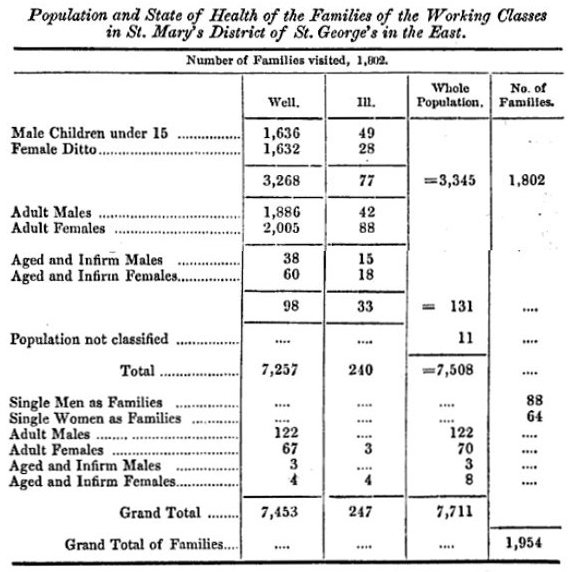
It is thus
seen that of the 7,711 persons here enumerated, 247, or 3∙923
per cent., are returned as being "ill". These numbers
include the children and those under 15 years of age. There is no
authentic record of the proportion constantly sick in this country at
all ages, including the young, but the records of Friendly Societies
will admit of a comparison for every term of life from the age of 10
upwards; and this comparison will, to some extent, be strictly
applicable, from the fact that of the 1,954 families now referred, to
677, or 34∙135, were
connected with Friendly Societies. The following will show the
proportion recorded ill in those families at various terms of life,
as well as the ratio constantly sick for the average of England and
Wales, among the members of Friendly Societies.
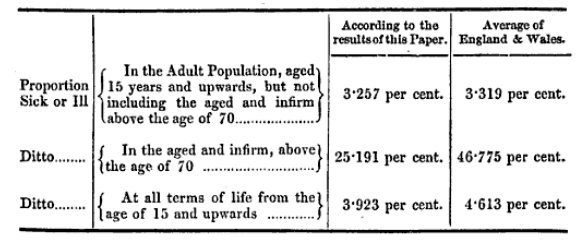 So far as
the preceding facts are available as a test of health, it is obvious
that the district now under consideration, must be regarded in a very
favourable light.
So far as
the preceding facts are available as a test of health, it is obvious
that the district now under consideration, must be regarded in a very
favourable light.
Further Tables, not reproduced here:
XVII - Ages of each Parent when first
Child born, Present Age of Parents, Number of Children they have had,
&c. [by occupation]
XVIII - Total of Present Age of Married
Women having no Children, classified according to Trades
XIX - Number of Children Born and
Living in Families, classified by the Mother's Age at the Birth of
the First Child - A 16-20, B 21-25, C 26-30, D 31-35, E Total Ages
14-43
XX - Average Average of Present Age of
Mothers, of Respective Trades Classified, with Averages of Children
Born, now Living, and Dead, to each; also Average Age of Mother when
First Child Bom, with difference between that and Present Age
XXI & XXII - [the same continued]
XXIII - Totals of Present Age of Mothers, of Respective Trades
Classified, with Children Bom, now Living, and Dead; and Total Ages
of Married Women having no Children inserted under Respective
Classified Ages and Trades
XXIV & XXV - [the same continued]
XXVI - Table of present Age of Mothers
of respective Trades, classified with Children Born, now Living and
Dead
XXVII - [the same continued]
Back
to History


 The St. Mary's district of St George's in the East was accordingly
selected for the elaborate analysis which it was determined to make;
and the portion concerning which it was ultimately found practicable to
obtain every varied item of information, was the great block of
habitations included between White Horse Lane, which is the
commencement of the Commercial Road, on the north, and Cable Street and
the New Road on the south; and between the New Road on the east and
Church Lane on the west. This is, in fact, the whole of St Mary's
district north of Cable Street; and it is one of those composed of
dingy streets, of houses of small dimensions and moderate elevation,
very closely packed in ill-ventilated streets and courts, such as are
commonly inhabited by the working classes of the east end; and indeed,
it may be said, of all parts of London beyond the limits of that
congested band round its centre, where overcrowding is carried to the
greatest excess.
The St. Mary's district of St George's in the East was accordingly
selected for the elaborate analysis which it was determined to make;
and the portion concerning which it was ultimately found practicable to
obtain every varied item of information, was the great block of
habitations included between White Horse Lane, which is the
commencement of the Commercial Road, on the north, and Cable Street and
the New Road on the south; and between the New Road on the east and
Church Lane on the west. This is, in fact, the whole of St Mary's
district north of Cable Street; and it is one of those composed of
dingy streets, of houses of small dimensions and moderate elevation,
very closely packed in ill-ventilated streets and courts, such as are
commonly inhabited by the working classes of the east end; and indeed,
it may be said, of all parts of London beyond the limits of that
congested band round its centre, where overcrowding is carried to the
greatest excess.
 Illness, in the meaning of the following table (II), is such as produces
confinement to the house, and incapacity for labour or exertion. The
proportion of such illness is small; and the appearance of the
children, even, is very healthy, wherever there is a sufficiency of
food; for they are early sent, as much as possible, out of the confined
rooms of their parents, though sometimes into little, filthy, smoky,
dame schools, by no means preferable; except that they have to pass
through the streets to arrive at them. Others of these schools,
however, are clean and fairly ventilated, and kept by persons with
habits of order and propriety.
Illness, in the meaning of the following table (II), is such as produces
confinement to the house, and incapacity for labour or exertion. The
proportion of such illness is small; and the appearance of the
children, even, is very healthy, wherever there is a sufficiency of
food; for they are early sent, as much as possible, out of the confined
rooms of their parents, though sometimes into little, filthy, smoky,
dame schools, by no means preferable; except that they have to pass
through the streets to arrive at them. Others of these schools,
however, are clean and fairly ventilated, and kept by persons with
habits of order and propriety.  The excess of foreigners, indicated by this table (III), is partly
attributable to some foreign sailors having their homes here, but
chiefly to the sugar bakers, being nearly all Germans; and to their
credit it ought to be added, that they are a cleanly, orderly, and well
conducted body of men, chiefly worshippers at the German chapel in the
neighbourhood.
The excess of foreigners, indicated by this table (III), is partly
attributable to some foreign sailors having their homes here, but
chiefly to the sugar bakers, being nearly all Germans; and to their
credit it ought to be added, that they are a cleanly, orderly, and well
conducted body of men, chiefly worshippers at the German chapel in the
neighbourhood.

 The preceding table (VII.) shows, in comparison with the average
earnings of the families in each trade, their weekly payments for rent,
carefully classified; the next following (VIII.) shows the number of rooms
occupied by the families, and the number of persons to a room; while a
third (IX.) states the number of beds possessed by each, and the number of
cases where there are one, two, three, or any greater number of persons
to a bed. The only remarkable result is the moderate degree of crowding
which prevails throughout the population. It is greatest, of course, in
the families having only one room, with several little children, but it
steadily decreases as each class increases in the number of its rooms
and its beds, showing that this is a population entirely above the
wretched system of sub-letting corners of the same room, which
occasions such an accumulation of wretchedness, barbarism, and disease,
in the few localities to which the rudest and most unsettled of the
population resort. Want of space and ventilation in the rooms is,
however, observed generally, and everyone can conceive how unfavourable
it is to domestic quiet to have only one room for every purpose of
repose and the ménage.
Indeed, the possession of only one room, indicates a depression of
habits and of health, which, if every grosser feature of misery were
removed, would well deserve the solicitude of the philanthropist; the
provision of a second room in town-life being as marked a step as the
advancement from a hovel to a proper cottage in the country.
The preceding table (VII.) shows, in comparison with the average
earnings of the families in each trade, their weekly payments for rent,
carefully classified; the next following (VIII.) shows the number of rooms
occupied by the families, and the number of persons to a room; while a
third (IX.) states the number of beds possessed by each, and the number of
cases where there are one, two, three, or any greater number of persons
to a bed. The only remarkable result is the moderate degree of crowding
which prevails throughout the population. It is greatest, of course, in
the families having only one room, with several little children, but it
steadily decreases as each class increases in the number of its rooms
and its beds, showing that this is a population entirely above the
wretched system of sub-letting corners of the same room, which
occasions such an accumulation of wretchedness, barbarism, and disease,
in the few localities to which the rudest and most unsettled of the
population resort. Want of space and ventilation in the rooms is,
however, observed generally, and everyone can conceive how unfavourable
it is to domestic quiet to have only one room for every purpose of
repose and the ménage.
Indeed, the possession of only one room, indicates a depression of
habits and of health, which, if every grosser feature of misery were
removed, would well deserve the solicitude of the philanthropist; the
provision of a second room in town-life being as marked a step as the
advancement from a hovel to a proper cottage in the country. 

 The state of these poor families, with regard to food, clothing,
furniture, and cleanliness, is described in Table X. There seems
to be indicated by the column showing the consumption of animal food, a
classification into poor and sufficient feeding; the former being very
clearly indicated by the two columns which represent those who very
clearly by represent obtain animal food only once or twice a week;
being about one fourth of the whole. None appeared to be over-fed. The
state of the clothing is, in one sense, more satisfactory; for while it
is described as sufficient in 1,031 cases, and insufficient in 852, it is described as dirty
in only 36 of the former cases, and 170 of the latter. The distribution
of these latter numbers chiefly among the poorer occupations will be
seen at a glance. Only 300 are returned as having rooms ill furnished, while 565 have rooms well furnished, but a number greater than both of these combined (925) are described as having only scanty
furniture; terms which are tolerably expressive to those accustomed to
visit the habitations of the poor. Ill furnished dwellings are those in
which there are only a wretched bedstead, or a bed on the floor, a few
broken chairs, and a table worth only a shilling or two, besides,
perhaps, a box or chest with a few paper pictures about the walls.
Scantily furnished dwellings are those which contain a few chairs, a
deal table, a flock bed, and a few cooking utensils, altogether
indicating a struggle towards neatness, though scarcely towards
comfort. While the dwellings described as well furnished had, perhaps,
a chest of drawers, a clock, really good tables, a carpet, mahogany
chairs, and every article essential to comfort, and some even of
luxury, such as a piano, violins, and other musical instruments, with
foreign productions of curiosity, &c.
The state of these poor families, with regard to food, clothing,
furniture, and cleanliness, is described in Table X. There seems
to be indicated by the column showing the consumption of animal food, a
classification into poor and sufficient feeding; the former being very
clearly indicated by the two columns which represent those who very
clearly by represent obtain animal food only once or twice a week;
being about one fourth of the whole. None appeared to be over-fed. The
state of the clothing is, in one sense, more satisfactory; for while it
is described as sufficient in 1,031 cases, and insufficient in 852, it is described as dirty
in only 36 of the former cases, and 170 of the latter. The distribution
of these latter numbers chiefly among the poorer occupations will be
seen at a glance. Only 300 are returned as having rooms ill furnished, while 565 have rooms well furnished, but a number greater than both of these combined (925) are described as having only scanty
furniture; terms which are tolerably expressive to those accustomed to
visit the habitations of the poor. Ill furnished dwellings are those in
which there are only a wretched bedstead, or a bed on the floor, a few
broken chairs, and a table worth only a shilling or two, besides,
perhaps, a box or chest with a few paper pictures about the walls.
Scantily furnished dwellings are those which contain a few chairs, a
deal table, a flock bed, and a few cooking utensils, altogether
indicating a struggle towards neatness, though scarcely towards
comfort. While the dwellings described as well furnished had, perhaps,
a chest of drawers, a clock, really good tables, a carpet, mahogany
chairs, and every article essential to comfort, and some even of
luxury, such as a piano, violins, and other musical instruments, with
foreign productions of curiosity, &c. This extensive profession of attachment to the Gospel is a hopeful
sign, though the limited extent to which the Wesleyans and other
denominations of Dissenters, appear to have penetrated into this mass
of population, is rather remarkable, and will justify a feeling of
doubt with regard to the profession made by some of belonging to the
Established Church.
This extensive profession of attachment to the Gospel is a hopeful
sign, though the limited extent to which the Wesleyans and other
denominations of Dissenters, appear to have penetrated into this mass
of population, is rather remarkable, and will justify a feeling of
doubt with regard to the profession made by some of belonging to the
Established Church. The following are the periodical publications in use among population:—
The following are the periodical publications in use among population:—
 One very gratifying fact is that 622, or upwards of one-third of the
heads of families are connected with Benefit Societies. On the other
hand, however, 50 families were in the actual receipt of gratuitous
medical relief.
One very gratifying fact is that 622, or upwards of one-third of the
heads of families are connected with Benefit Societies. On the other
hand, however, 50 families were in the actual receipt of gratuitous
medical relief. Again, the great length of time which a large proportion of them have
occupied their present habitations, indicates, in the main, a
steadiness of character which is worthy of observation, if we take into
account the large proportion of forced migration which attaches to a
number of the trades; if only from one part of the town to another.
Again, the great length of time which a large proportion of them have
occupied their present habitations, indicates, in the main, a
steadiness of character which is worthy of observation, if we take into
account the large proportion of forced migration which attaches to a
number of the trades; if only from one part of the town to another. The tables of the attendance of the children in schools, and the payment made by their parents for that attendance, are very
interesting; indicating, as they do, an universal use of schools for
some period of life, and obviously also for successive years. Of the
quality of the schooling we have other and less flattering means of
judging, by analogy.
The tables of the attendance of the children in schools, and the payment made by their parents for that attendance, are very
interesting; indicating, as they do, an universal use of schools for
some period of life, and obviously also for successive years. Of the
quality of the schooling we have other and less flattering means of
judging, by analogy. 
 The table of school payments affords a very interesting view of the
payments which the several classes of families are willing to make for
the schooling of their children, while of all the families returned the
children of only 13 were receiving absolutely gratuitous education.
The table of school payments affords a very interesting view of the
payments which the several classes of families are willing to make for
the schooling of their children, while of all the families returned the
children of only 13 were receiving absolutely gratuitous education.  The following table will show the ages
of the parents at the birth of their first child; and if it be
assumed, that the birth of the first child, on the average, happened
about one year after marriage, it will be seen that in both sexes the
greatest number of marriages took place, between the ages of 21 and
25. However, it will be found that the marriages in the male sex have
taken place generally at a much later period in life than among the
female sex, for while out of 1,488 marriages 170 only of the males
were under 20 years of age, as many as 461 females were under the
same age. On the other hand, while 236 only of the females were
between the ages of 26-30, there were as many as 391 males at those
ages. Again, while there were only 68 females married above the ages
of 30, it will be found that as many as 223 males were married above
that age.
The following table will show the ages
of the parents at the birth of their first child; and if it be
assumed, that the birth of the first child, on the average, happened
about one year after marriage, it will be seen that in both sexes the
greatest number of marriages took place, between the ages of 21 and
25. However, it will be found that the marriages in the male sex have
taken place generally at a much later period in life than among the
female sex, for while out of 1,488 marriages 170 only of the males
were under 20 years of age, as many as 461 females were under the
same age. On the other hand, while 236 only of the females were
between the ages of 26-30, there were as many as 391 males at those
ages. Again, while there were only 68 females married above the ages
of 30, it will be found that as many as 223 males were married above
that age. Tables a, b, c, d, and e [not included here] are
abridgments of the preceding tables. The first point deserving of
attention in those figures is the circumstance that those marriages
formed at an earlier period of life are more prolific than those
formed at a later period. The gross results for each group of facts
is as follows: —
Tables a, b, c, d, and e [not included here] are
abridgments of the preceding tables. The first point deserving of
attention in those figures is the circumstance that those marriages
formed at an earlier period of life are more prolific than those
formed at a later period. The gross results for each group of facts
is as follows: — It is thus
obvious, that marriages formed under the age of 25, are more prolific
than those formed after that age, and that those formed between 16
and 20 years of age are still more so than those at any of the
superior ages.
It is thus
obvious, that marriages formed under the age of 25, are more prolific
than those formed after that age, and that those formed between 16
and 20 years of age are still more so than those at any of the
superior ages.
 From this
abstract it is obvious, that of the three first periods, the children
born of marriages formed in the quinquennial term of life, 21-25, are
subject to a less rate of mortality than those of the period
immediately preceding or immediately followingm the rate of mortality
in the most advanced period 31-35, is very irregular, and no doubt
arises from the small number of families included in that group. The
two preceding series of facts furnish materials for the solution of a
very interesting and highly important question, namely, what is the
effect of the marriages formed at those different terms of life on
the ultimate increase of population? By the first of the two
preceding abstracts it was found, that the earlier the period of life
at which marriage was contracted, the greater the number of children
born; but by the second abstract a difference is observable in the
rate of mortality of the various periods, and this must disturb the
results in the first class of facts.
From this
abstract it is obvious, that of the three first periods, the children
born of marriages formed in the quinquennial term of life, 21-25, are
subject to a less rate of mortality than those of the period
immediately preceding or immediately followingm the rate of mortality
in the most advanced period 31-35, is very irregular, and no doubt
arises from the small number of families included in that group. The
two preceding series of facts furnish materials for the solution of a
very interesting and highly important question, namely, what is the
effect of the marriages formed at those different terms of life on
the ultimate increase of population? By the first of the two
preceding abstracts it was found, that the earlier the period of life
at which marriage was contracted, the greater the number of children
born; but by the second abstract a difference is observable in the
rate of mortality of the various periods, and this must disturb the
results in the first class of facts.
 It hence
follows, that marriages formed under 25 years of age increase the
population more than those formed above that age; and on a close
examination it will be found, that there is very little difference in
this respect between marriages contracted at ages 16-20 and 21-25,
the rate of increase, however, being somewhat higher in the former
period. With regard to the last two quinquennial terms at which
marriage is formed, it will be seen that the rate of increase is not
so great for ages 26-30 as in that immediately preceding, and in the
period 31-35 the rate of increase is still less; in fact, the earlier
the period of marriage the greater the increase resulting to the
population, the difference between the first and second periods being
very little, between the second and third very considerable, about 23
per cent., and between the third and fourth about 20 per cent.
It hence
follows, that marriages formed under 25 years of age increase the
population more than those formed above that age; and on a close
examination it will be found, that there is very little difference in
this respect between marriages contracted at ages 16-20 and 21-25,
the rate of increase, however, being somewhat higher in the former
period. With regard to the last two quinquennial terms at which
marriage is formed, it will be seen that the rate of increase is not
so great for ages 26-30 as in that immediately preceding, and in the
period 31-35 the rate of increase is still less; in fact, the earlier
the period of marriage the greater the increase resulting to the
population, the difference between the first and second periods being
very little, between the second and third very considerable, about 23
per cent., and between the third and fourth about 20 per cent.

 Beyond the
age of 30, the facts in this paper are not sufficiently numerous to
warrant a comparison being instituted between them and other life
tables, but from the illustrations already brought forward, it will
be seen that the rate of mortality in the first year of life, is less
than in any other of those cases. Again, with respect to the
decrement of life between birth and the tenth year, it is greater
than that for England and Wales, the county of Surrey, the
Metropolis, the Carlisle Table, and that for the kingdom of Swedenm
but less than the decrement for the select lives in Francem the towns
in France, Northamptonm Liverpool and Montpellier.
Beyond the
age of 30, the facts in this paper are not sufficiently numerous to
warrant a comparison being instituted between them and other life
tables, but from the illustrations already brought forward, it will
be seen that the rate of mortality in the first year of life, is less
than in any other of those cases. Again, with respect to the
decrement of life between birth and the tenth year, it is greater
than that for England and Wales, the county of Surrey, the
Metropolis, the Carlisle Table, and that for the kingdom of Swedenm
but less than the decrement for the select lives in Francem the towns
in France, Northamptonm Liverpool and Montpellier. In viewing
the decrements of life from birth only, it was found that the results
of this paper were intermediate in the scale between the table for
Sweden and that for the select lives in France, that comparison was
of course affected by the rate of mortality in infant life; but in
the above tables, where the results of advanced life only enter into
the figures, it is seen that the mortality is higher than that of all
the tables, except those for the towns of France and for Northampton.
In viewing
the decrements of life from birth only, it was found that the results
of this paper were intermediate in the scale between the table for
Sweden and that for the select lives in France, that comparison was
of course affected by the rate of mortality in infant life; but in
the above tables, where the results of advanced life only enter into
the figures, it is seen that the mortality is higher than that of all
the tables, except those for the towns of France and for Northampton. It will thus
be seen, that nearly two thirds of the families have been less than
three years in their present residence, and more than one-fourth
between one and three years only. The term "in their present
residence" will admit of the explanation that they may have been
much longer in the same neighbourhood. Still many amongst those who
have changed their dwellings must also have been recent inhabitants
of the locality, and it must therefore follow that the younger lives
indicate more strictly the sanatory [sic] condition of the place than
those of more advanced age. The high rate of mortality of the older
lives now under review can, consequently, not be attributable to
residence in Whitechapel, as the majority of the deaths in advanced
life may have taken place elsewhere—one-thirteenth
only of the families having occupied their present residences upwards
of twelve years; but with respect to the deaths at the younger ages,
the greater number of those must have happened in the locality, and
hence the comparative healthiness of the district.
It will thus
be seen, that nearly two thirds of the families have been less than
three years in their present residence, and more than one-fourth
between one and three years only. The term "in their present
residence" will admit of the explanation that they may have been
much longer in the same neighbourhood. Still many amongst those who
have changed their dwellings must also have been recent inhabitants
of the locality, and it must therefore follow that the younger lives
indicate more strictly the sanatory [sic] condition of the place than
those of more advanced age. The high rate of mortality of the older
lives now under review can, consequently, not be attributable to
residence in Whitechapel, as the majority of the deaths in advanced
life may have taken place elsewhere—one-thirteenth
only of the families having occupied their present residences upwards
of twelve years; but with respect to the deaths at the younger ages,
the greater number of those must have happened in the locality, and
hence the comparative healthiness of the district.
 So far as
the preceding facts are available as a test of health, it is obvious
that the district now under consideration, must be regarded in a very
favourable light.
So far as
the preceding facts are available as a test of health, it is obvious
that the district now under consideration, must be regarded in a very
favourable light.